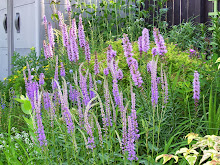
Growing blueberries in Wisconsin can be super easy or incredibly difficult. There are places in Wisconsin where a gardener can literally plant them in the ground and walk away (Wisconsin Rapids through Tomah). Other places, this part of central Wisconsin-- not so much. A clue for you, if Ocean Spray or one of the other big cranberry producers is growing cranberries in your area, you're a lucky gardener when it comes to blueberries.
The rest of us, buckle up for the ride.
The biggest problem, other than pricey plants(!), is generally the blueberries for sale in your big box store are not necessarily the ones best suited for your growing area. I have had the good fortune to be able to discuss blueberry growing with a doctor of horticulture and one of the larger blueberry farmers in the Midwest. Without getting in the difference between high bush and low bush blueberries, when it comes to cultivars, choose those with the words "blue" or "north" in their cultivar name. Good examples are 'Blueray', 'Northsky', or 'Northern Blue'. Another cultivar, which is really a selection of the native wild variety found here in Wisconsin is 'Friendship'.
'Friendship' has a lot going for it; hardiness, disease resistance, good wild blueberry taste, and yield. The down side is the berries are smaller.While blueberries can self-pollinate, it is recommended you choose a couple varieties with overlapping bloom times for heavier yield.
Blueberries are strange as I have seen some cultivars with ripe berries, while other are coming into bloom. Nor do the berries ripen all at one time. The berry production seems to be spread over a fairly lengthy time frame. For these reasons, you need to set out a number of plants to provide enough berries at any given time, if you intend to preserve them or make a pie. In the family garden, I planted 20 plants of two varieties. In my own potager, I have six plants.
After you have chosen your plants, you need to think about your soil. Freely draining soil with lots of organic material is best. Blueberries like water, too, although do not care for wet feet. Counter-intuitively, blueberries could do as well in a swamp as a hilly ravine.
Acidity of the soil is the next hurdle for the would-be blueberry gardener. Here in central Wisconsin, the rain actually has an alkaline pH. The very water from the sky is working against the pH you need to build into your soil to support blueberry culture. The acidity that is the same thing that azaleas need to thrive, and your hydrangeas need to be blue is necessary to blueberries. Without this acidity, it is difficult for blueberry roots to extract the elements from the soil it needs to survive, putting your blueberry plants in a constant state of stress.
I have had some luck with azaleas by over-fertilizing them and careful watering. It is possible the home blueberry gardener could have good luck the same way. It is much easier to work a lot of organic material into your planting area beforehand and top-dress seasonally with the same spaghum peat moss. Some gardeners may not prefer the esthetic but mulching with a four-inch layer of pine needles each year is also helpful. In the picture above, I am also taking advantage of the natural acidity of the cellulose in shredded paper by using my caged blueberry area as my shredded paper composting area.
Here in central Wisconsin, rabbits are an issue. Deer, however, can be just as bad. There is a country road winding back and forth not far from here through a cutout in a hill with the Blueberry Hill Road. When I was a child, I would pick blueberries on this hill. Now, I would be hard put to find more than a couple plants. Increases in the deer herd and its browse of these plants through the winter has all but decimated these plants. So a fencing and netting (birds, should you get to the berry-producing stage) is vital.
Unless they yet freeze, always a possibility it seems in central Wisconsin, my blueberries look like I may just have a few batches of blueberry muffins in my future from these bushes I planted last spring.

































